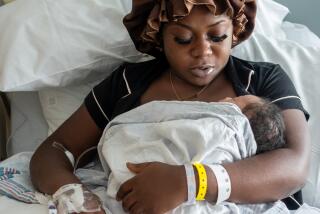Fighting for Life at an Early Age
- Share via
TARZANA — With a watchmaker’s care, nurse-practitioner Carol Greene feeds the catheter into a vein in the crook of the girl’s arm. She snakes it, millimeter by millimeter, up the arm and into the chest, aiming to place its end in the superior vena cava, which drains blood into the heart.
The problem is, the girl’s superior vena cava, like everything else about her, is not very superior.
Her head, for instance, is the size of a racquetball, her arms and legs no bigger than Greene’s fingers. Her trunk would fit into the palm of Greene’s hand. She weighs 23 ounces.
The clear plastic catheter is about 1/64th of an inch in diameter, the size of thick sewing thread. As she coaxes it in with tweezers, Greene must take care not to push it too far lest it puncture the papery walls of the girl’s heart.
The catheter’s insertion marks a turning point in the girl’s day-old existence in the world of air, light and unmuffled noise. It will allow her to receive the kind of nourishment that, if myriad other complications are kept at bay, will make up for all the development unaccomplished during her scant 26 weeks in the womb.
For now the girl exists as indisputably at the beginning of human life as medicine and law have been able to discern. Two weeks ago, as fetus, she could have been legally aborted.
Over the last 15 years, advanced medicines and new, gently puffing ventilators have nudged the viability limit deeper and deeper into early gestation. Still, if the girl had debuted three weeks earlier, there would have been little chance that the people and technology in the neonatal intensive-care unit at Encino-Tarzana Regional Medical Center could have kept her alive.
“Although such a baby might scream in the delivery room once or twice, there’s really nothing you can do,” says unit medical director Dr. James Banks. “There is insufficient development of basically everything. It’s not that the body is too small. It’s that it doesn’t function effectively. There’s just not enough stuff there.”
The neonatal ICU at Tarzana-Encino is a place of low lighting and deservedly high hopes. Here, 57 doctors, nurses, therapists and social workers labor over 22 infant cribs, 14 of which were occupied in the middle of last week. Nearly all the babies who enter the unit--99%, Banks says--leave it alive.
The costs are considerable, an average of about $1,000 a day per infant. Patients such as the 23-ounce girl and her 28-ounce twin sister likely will require 100 days in the unit before they can be taken home with all operating systems functioning like those of full-term babies.
For now, the 23-ounce girl, who is kept covered with what looks like a sheet of Saran wrap because she hasn’t developed the external layer of skin that retains body moisture, is doing remarkably well for someone her age. Her spontaneous movements are vigorous, and the boiled-pink look of her skin is a sign that blood is circulating effectively.
Nonetheless, her small size places her in a statistical category in which the survival rate is only a little above 50%, Banks says. She was born about 4 ounces shy of the category in which almost all survive.
A major concern about such very premature infants is stiff, immature lungs that essentially collapse after every exhalation. Another is bleeding in the brain. The latter tends to occur in a highly venous area that exists only temporarily during gestation, but is vulnerable to rupturing with changes in blood pressure when an infant is out of the womb. This can kill or cause devastating lifelong incapacitations.
The 23-ounce girl, however, is breathing mostly on her own; she needs the ventilator to contribute only 14 of the 66 breaths she takes each minute. She’s shown no signs of brain bleeding. “If she can get through the first five days without a bleed in her brain, she won’t have one,” Banks says.
One day in the near future, the girl may have a visitor, another large face looming over her clear-sided crib. This one will be a little special, though. It will be Michele Aprahamian of North Hollywood.
Michele is a 16-year-old high school sophomore who is 4 feet, 11 inches tall and hopes one day to become a psychologist.
Every Friday, she volunteers at the hospital, running errands, helping patients to their cars and so on. From time to time, she finds herself working in neonatal intensive care.
Michele’s connection to the unit is visceral. Sixteen years ago she was the unit’s inaugural preemie, having entered the world at 21 ounces.
“I went to a reunion they had for premature kids a couple of years ago, and one of the nurses told me I could work in the volunteer program if I wanted,” Michele says. “So I thought, ‘Yeah. I’ll help.’ ”
When she next works the neonatal intensive-care unit, she imagines she’ll have a look at the 23-ounce girl. She’ll think, as she always does when checking out a tiny newcomer, “It’s kinda scary. Like, whoa--I used to look like that.”
Looks, however, are deceiving, even in the case of people who don’t weigh a lot more than the baby blankets that cover them.
The unit’s infants, beset by complicated medical tackle and sometimes issuing kittenish squeals, may look like anonymous bundles of need and extreme vulnerability. Those who care for them, however, insist unique personalities come with the fragile lungs and rice-grain fingernails.
The 23-ounce girl may have but 26 weeks’ gestation in her history, “but everything’s there--her hair, her fingerprints, her attitude,” says nurse Kathy Seemann, who is assigned to the infant full-time. “She is feisty. She fights me all the time. Yesterday she pulled all of her tubes out. I went home exhausted. But she’s fighting to stay alive. She’s a fighter, and she’ll be fine because of that.”






